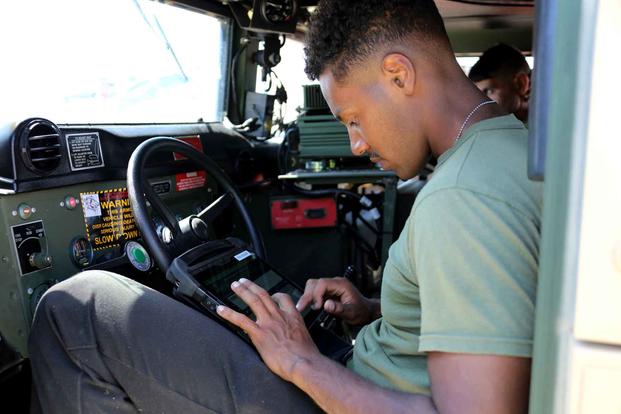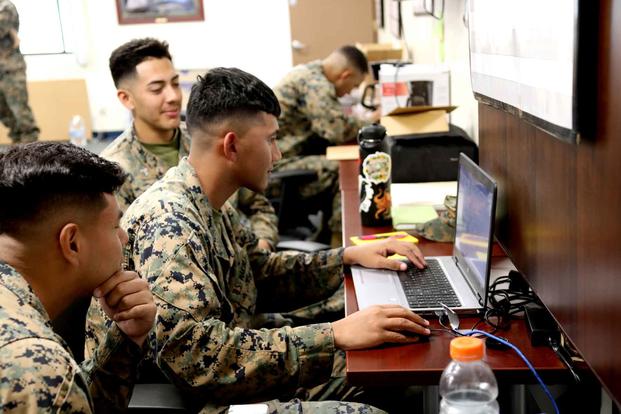From the Battle of Belleau Wood to the shores of Inchon, the Marine Corps has fought in some of the most hostile conditions America's wars have had to offer. Now, to better prepare for an increasingly unstable future, it's entering the metaverse.
Last month, Marines with the Marine Corps Platform Integration Center, or MCPIC, successfully fielded a "real-time pilot set in a planetary-scale metaverse environment," according to CGI Federal Inc., an information technology (IT) and business consulting firm that presented the pilot to the service.
Not to be confused with Facebook parent company Meta's use of the term, the metaverse that the Marines are hoping to dive into is also a simulated environment, one that will take billions of dollars in Corps equipment and make "faithful twins" of it in a simulated reality.
Read Next: Caregivers of Veterans Spend $11,500 on Average Each Year on Expenses, New Data Shows
"The pilot involved integrating the Marine Corps Platform Integration Center [MCPIC] logistics and asset management systems with digital twins, or virtual replicas of physical assets in a simulated world environment," the CGI press release said. "The integration demonstrated how the Marine Corps can achieve enhanced visualization, real-time monitoring, simulation capabilities, and predictive analytics that will augment training and education, as well as operational efficiency."
In simple terms, this metaverse is billed to be anything between a tabletop exercise of the future to hands-on planning from anywhere in the world: weather simulations, fuel-level measurements, and orientation and locations down to meters -- the high-tech potential for the Corps seems endless.
"We're focused on bridging the real and the surreal a little more closely," Victor Foulk, the vice president of emerging technologies for CGI, told Military.com in a recent interview.
Right now for the Marine Corps, that means taking equipment, scanning it and replicating it into a massive simulated environment with real-world mechanics, physics and geolocation.
What might that look like for the Marine who would use it, and when exactly would it end up in their hands? The Corps is still figuring it out -- but virtual reality (VR) headsets and Star Wars-like interactive maps are not out of the question, CGI and the Corps said.
The push for the metaverse comes from a pressing requirement, the Corps said. As the service sets its sights on the Pacific, Maj. Jeff Planteen, the operations officer for Blount Island Command in Florida, where the pilot was fielded, explained that the need for distributed planning is increasingly important.
"Everything's too far apart to really consolidate our assets as we set the theater," Planteen told Military.com, referring to the many island chains in the Pacific that present planning challenges different than those encountered in landlocked Afghanistan, for example. "So we need a way for local commanders to be able to see where their items are, what is coming to them ... [and] how those items are loaded."
This simulated environment is first being tested with logistics, where it will be used to plan, pack and deploy Marine Corps equipment. That equipment can range from Meals Ready-to-Eat (MREs) to LAV-25s, which would then be transformed into replicas within the metaverse, saddled with the same physics and tracked in real time.
Planteen said that the MCPIC already uses "passive RFID [radio frequency identification] tags" to mark that equipment, some of which are just a few dollars and are disposable if need be. Marines then can use tablets to track the equipment and statistics associated with, say, a vehicle and its maintenance status. By piggybacking off this tracking, CGI can then upload "honest replications" of the equipment into an enormous, simulated environment, Foulk said.

So, Planteen said, a supply sergeant or loadout leader could be hundreds or thousands of miles away from where a ship needs to be unloaded and they can see in real time how it is packed, how the vehicles or equipment is oriented and then figure out the best way to offload it once in theater.
"If I can put a VR headset on a Marine and allow them to see exactly how that ship is loaded ... and I can do that anywhere in the world through a headset or a computer," Planteen said, "I don't have to put that Marine on a ship early ... to figure out where everything is or look at that two-dimensional paper load plan like we've been doing forever.
"We don't have to do that anymore," Planteen said. "I can show you exactly how things are right now, as loaded."
Military.com spoke to two Marine Corps logistics officers who were granted anonymity to speak freely about the capability, how they would use it and what concerns they might have about embarking into the metaverse.
"You're reducing risk of unknowns, and damage to equipment or loss of personnel," one officer told Military.com. "If I lose an operator to crushed fingers or crushed toes when they're offloading equipment or moving stuff in tight spaces -- that's a licensed kid with hundreds of hours experience. I can't grow him, and I can't simply replace them."
The officers also said that rehearsing the large movements in the metaverse would be advantageous for commanders before they deploy or have Marines put hands on equipment. Plus, it could be used in training and schooling settings to get Marines accustomed to real-world scenarios that they may not see until they reach the fleet.
"We're talking about planning and execution and real-time uploads within 15 meters anywhere in the world. I would even take it back to the schoolhouse setting and when Marines are earning their MOS [military occupational specialty]," the other officer said. "This will give Marines a lot better understanding of what they're actually doing in a practical application sense."
As for concerns, the Marines said that the risk of breaking equipment needed to run the metaverse -- if it was lugged around through rough environments -- could make it less desirable.
"How do you energize things?" one Marine said, asking specifically about how the metaverse would be powered if it were brought to theater, for example. "Is it going to be rugged enough like a hammer ... [or] it's going to fall apart after the third swing?"
Another concern is data security and encryption. Military.com asked if uploading massive amounts of data on Marine Corps assets, ones that could be tracked in real time, would present a security risk, especially if it were a high-priority data target for adversaries.
"I can't argue with you on that," Scott Prouse, supervisor for the Automated Systems Group, Command Data and Analytics Office at Marine Corps Logistics Command, told Military.com.
"I can tell you that MCPIC is a fully accredited platform; we adhere to all the security protocols that are mandated by DoD," he said, adding that the data the MCPIC was working with wasn't "especially sensitive."
"We're in the process of moving to the cloud so we can be even more secure," Prouse said. "So your point is well taken, but we're following all of the rather stringent guidelines that are required to maintain accreditation."
Foulk was hopeful about the Marine Corps foray into the metaverse.
"We're talking about operations planning, like tabletop exercises, based on actual asset management and force readiness conditions, as opposed to postulated," he said. "This is absolutely an elevated tabletop, exercise operational planning tool that can function at a much larger scale, with a much higher fidelity of information based on reality."
-- Drew F. Lawrence can be reached at drew.lawrence@military.com. Follow him on X @df_lawrence.
Related: Marine Corps Wants Lighter .50 Caliber Ammunition to Reduce the Burden of Weight on the Battlefield














